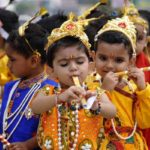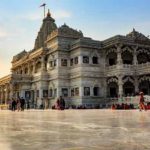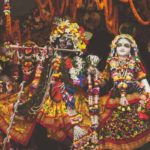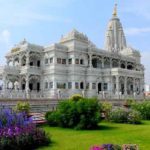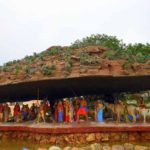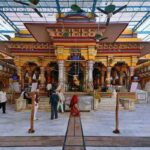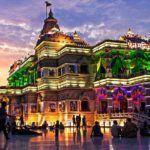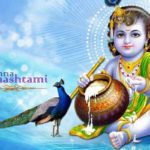Best Places to Visit in Mathura As spirituality is mixed in every bit of India, there is an endless number of holy places in the country. The most famous among them is Mathura – the birthplace of Lord Krishna. Located around 150 kilometers from Delhi, Mathura is dotted with many beautiful temples of Lord Krishna. You can visit these temples with the Mathura travel guide that will allow you a hassle-free tour to the Braj-Bhoomi. The entire region of Mathura flaunts several shrines that describe the different phases of life of the almighty. The famous temples include Dwarkadhish Temple, Krishna Janmasthan Temple Complex and Gita Mandir. Pride of the Mathura tourism, various temples and Ghats like Vishram Ghat in the city allow the devotees to observe the life of Lord Krishna from close quarters.
Mathura has its twin holy city Vrindavan at a distance of 10 km which is also dotted with many beautiful temples. Some of the famous temples areBankey Bihari Temple, Rangaji Temple, and the ISKCON Temple that you can visit during your Mathura Vrindavan tour. Located on the bank of the river Yamuna, Mathura exudes a sacred aura, attracted by which many devotees visit the place again and again. With our Mathura guide, you can make your trip bereft of any hassles. Mathura also offers mouth-watering milk products like Peda and intricate handicrafts that relate to the life of Lord Krishna. Our well-planned Mathura tour guide gives you detailed insights about the festivals like Holi and Janmashtami which are celebrated with great fervor and enthusiasm.
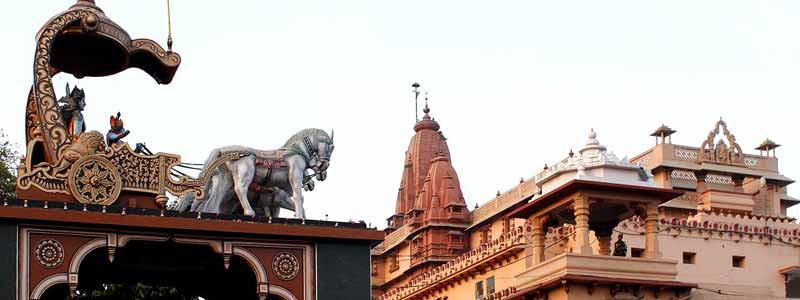
Sri Krishna Janmabhoomi Temple
The most famous of Mathura’s temples is the Krishna Janmasthan Temple, built around the prison cell where Krishna was born after his parents were imprisoned by his evil uncle, Kansa, king of Mathura. One of the most venerated shrines in India, the temple complex is located west of Mathura’s old city and thronged by pilgrims throughtout the year, whose number increases exponentially during festivals.
It is believed that there was a massive idol of Krishna, over 4m tall and made of solid gold, which was stolen during an attack by Mahmud of Ghazni. The present Krishna Janmasthan Temple complex is fairly new. Inside, visitors will find paintings of scenes from Krishna’s life, idol of Krishna, Balrama and his beloved, Radha, and a stepped water tank.
Tourism in Mathura revolves around places connected to Lord Shri Krishna, Lord Vishnu’s incarnation. One of the Hindu pilgrimages is Mathura, part of Braj Bhoomi and the location where Shri Krishna spent his childhood. On the west bank of the Yamuna River, which flows mainly undisturbed from Delhi to Agra, is the town of Mathura. Rites on the Yamuna consist partly of launching hundreds of lighted oil lamps at dusk on the river, a pretty sight. But like all religious places in India, Mathura is the grotesque and the sublime lie cheek by jowl, not without its paradoxes. The birthplace of Krishna is Mathura and it is revered by Hindu pilgrims as such. A shrine in one part of the town known as Katra is their destination.
A Hindu temple once stood there, demolished by Aurangzeb, who had founded a mosque on the site. “But the temple’s basement remains and so does a sign declaring” Krishna ‘s Birthplace. Mathura’s holiness is all pervading, actually attracting Lord Vishnu’s worshippers in the same way as Benares attracts Lord Shiva’s worshippers, the Destroyer. As Lord Shiva ‘s followers flock to the Ganges, The Yamuna and, in particular, the Vishram Ghat {ghat means a river terrace) attract pilgrims to Mathura. It is here, tradition states, that after the tyrannical Kansa was slain, Shri Krishna slept. Kansa was Shri Krishna ‘s maternal uncle and Lord Krishna was born in his prison / gaol.
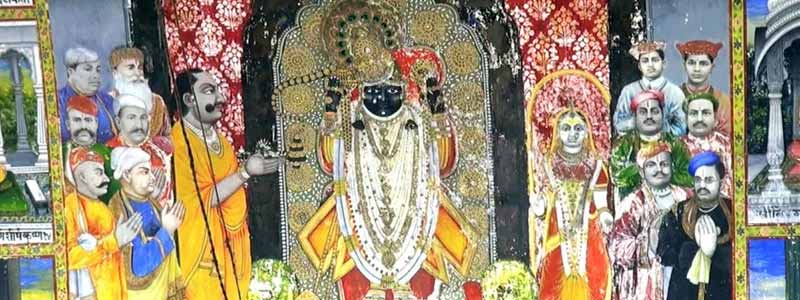
Dwarkadhish Temple
Sri Dwarkadheesh Mandir is one of the oldest and largest temples in the Indian States of India, India, in Mathura District. This is a large and prominent Hindu shrine, and Seth Gokul Das Parikh, the treasurer of the then Gwalior State (Scindia) in 1814, built its present structure. It was built for the famous Hindu deity Dwarkadheesh (meaning the God or King of Dwarka, where Lord Krishna moved from Mathura and settled on earth until his life). Lord Dwarkadheesh, a form of Lord Krishna seen in the black marble idol called Dwarkanath, is the main deity there. With him is the white marble statue of the god Sri Radharani, his counterpart.
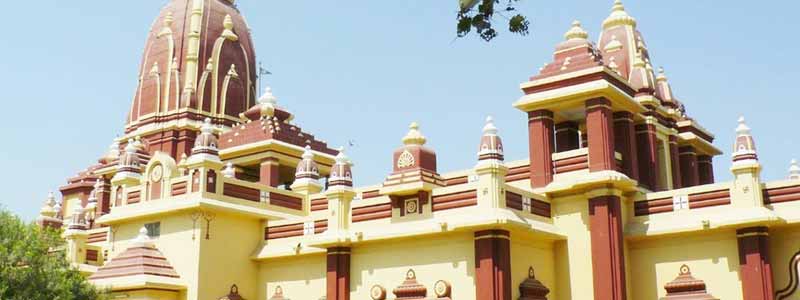
Birla Temple/Gita Mandir
Also known as Gita Mandir, Birla Mandir is situated on the Mathura-Vrindavan road on the outskirts of Mathura. Birla Mandirs have become iconic throughout India for their grandiose design and architecture and are iconic landmarks wherever they are built. Jugal Kishore Birla built this grand temple, which is one of the most prominent temples in Mathura. He was inspired to create the temple by his devotion to Laxmi Narayana (an avatar of Lord Vishnu) and his eternal song, Bhagwat Gita. As its main room is decorated with all the verses of the Gita, it is called the Gita Temple. The depictions of Arjuna in a chariot, along with his friend and guide Krishna, are inspiring and enjoyable.
However, turn your attention to its architecture, and you see a peculiar combination of Hindu and Western architectural styles. This famous temple in Mathura, built in red sandstone, announces its stately presence very noticeably. There are two impressive marble structures in this temple that are big attractions. The Gita Stambh (Pillar) is one and the Temple of Hanuman is the other. Built from red sandstone, the Gita Stambh, or the Victory Tower as it is also called. All the holy teachings of the Bhagavad Gita, the everlasting source of knowledge for humanity, are engraved on it. With sharp precision, the verses were inscribed, with each letter as discernible as the other. To come across it is an inspiring sight.
Other statues that attract tourists are those of Lord Krishna in the presence of Lakshmi Narayan, Ram and Sita in the Birla / Gita Mandir. You also come across Krishna’s chariot inside the temple, along with wonderful pictures on its marbled walls of various gods and goddesses.
Vishram Ghat
Vishram Ghat is a serene place surrounded by trees, creepers and flowers on the bank of the Yamuna river. Here, Sri Krishna used to rest with his friends while the cows in the field were grazing. The place where Sri Krishna used to play the flute sitting on the brunch of a Kadamba tree is spiritually important.
As Sri Radha used to come here to collect water from the Yamuna River and also spend a good time with Sri Krishna, this sacred Vishram Ghat is popular among devotees. It is the Ghat bathing place where Sri Krishna’s devotees come to take a holy dip in the Yamuna River. In Mathura, there are a total of 25 Ghats, and Vishram Ghat is the biggest and most famous of them.
Mathura Vishram Ghat is made of marble stone and the entrance has a wide arch. There are a lot of lovely temples surrounding the Ghat. Yamuna-Krishna, Radha-Damodar, Mukut Temple, Neelkantheshwar, Langali Hanuman, Murali Manohar, and Narasimha are some of the main temples.
After a holy dip in the water, the devotees usually start a Parikrama (circumambulation) of the temples and return to the same spot.
Kusum Sarovar
Kusum Sarovar is an enormous tank belonging to the time of Lord Krishna, situated between Govardhan and Radha Kund, 28 km from Mathura. Kusum Sarovar lies nearly a mile and a half from Radha Kund on the right side of the sacred Govardhan parikrama road.
Kusum Sarovar is set against a milieu of exotic palatial buildings built of sandstone in Govardhan. The 450-foot long and 60-foot deep tank of Kusum Sarovar ghat is marked by a flight of stairs bordering the lake all sides. In order to explore the Kusum Sarovar history of construction and restructuring, travellers from all over the world visit the site. The Sarovar has exquisite architecture engraved with awe-inspiring workmanship from Rajasthani. Originally, the pond was a very simple structure; the beautiful aesthetics we see today are the result of a renovation undertaken in 1735 on the orders of King Veer Singh of Bundelkhand, Madhya Pradesh.
After some time, Suraj Mal rebuilt a garden for his queen and transformed it into a beautiful location. The Kusum Sarovar is surrounded in the soulful Goverdhan by splendid sandstone buildings designed by the King of Bharatpur Jawahar Singh in the middle of the 18th century. In memory and in honour of Raja Suraj Mal, his father, these glorious groups of buildings were erected.
Govardhan Hill
Godhan Hill is set at a distance of 22 km from Mathura. It has been expressed in the Holy Bhagwat Gita that Godhan Parvat is not exactly the same as him, as per Lord Krishna. Therefore, the unadulterated rocks of the slope revere and of his admirers just as they love his object of worship. The slope consists of sandstone and stands 80 ft tall with a 38 km limit. You get the chance to visit the hills, including Mansi Ganga, Mukharvind, and Daan Ghati, some interesting locations. History says that in the midst of his youth, Lord Krishna raised the Godhan Hill on one finger to spare his town of Mathura from savage downpours and electric storms. This slope is thought of as divine along these lines and is gone by admirers of Guru Purnima, Godhan Puja in devotion by walking 23 km shoeless around the peak.
Government Museum / Mathura Museum
Mathura is one of the holiest places regarded as Lord Krishna’s place of birth. This city is located on the banks of the Yamuna River, which also holds the history of the period of Krishna. It is located approximately 145 kilometres from Delhi, India’s capital, and 58 kilometres from Agra. It draws visitors from around the world to see its magnificent temples, shrines, Rangbhoomi and the Museum of Government. This town is renowned for about 3000 years of culture and civilization. Since that time, this city has been blessed with paintings and creative arts. In terms of art and culture, the Government Museum in Mathura has all kinds of innovation, so it is popularly known for its art and architecture along with details that sheds light on different types of art and popularises this place as the best tourist place to visit in India along with other tourist places such as Agra, Delhi, etc.
The Mathura Government Museum is well-known for its amazing art and architecture. It is famous for ancient Mathura art school sculptures dating from the 3rd century to the 12th century. This museum was established by Sir F.S Growse, who was the district collector of Mathura, in 1874. It is known as the Museum of Archaeology as well. The museum ‘s significance and beauty lies in the valuable items it holds, which can be in terms of art, history, scripts, currency, etc. It has a large collection of sculptures belonging to the art school of Mathura, many ancient coins, paintings, transcripts and other valuable objects from all around the 3rd to 12th century area. As they were more prominent in this region and the districts of Mathura, the Government Museum has the artefacts of the Gupta and Kushan kingdoms. The most enticing collection at this museum is the renowned collection of sparkling ornaments, terracotta sculptures and bronze artefacts.
Kans Qila
Kans Qila is situated on the northern banks of the Yamuna stream. This qila symbolises a mixture of Muslim and Hindu engineering as well. Arranged near the Krishna Ganga ghat and the Gau ghat in Mathura, the remains of the fortification can be seen by voyagers. Raja Man Singh of Amber, the Rajput general of the Mughal sovereign Akbar, remodelled the fortress in the late sixteenth century.
Kans Qila in Mathura, believed to be the fort of Kansa, the Maternal Uncle of Lord Krishna, is one of the tourist attractions. It, therefore, dates back to the 7th century BCE era of the great epic Mahabharata. In Mathura, Kans Qila is situated near Krishna Ganga Ghat and Gau Ghat. This fort (qila) was built in a wide area that had a long wall fenced in. The fort was destroyed over the years, and in the 16th century, Raja Man Singh of Amber, who was the Mughal Emperor Akbar’s general, renovated it. The fort ‘s architecture is a combination of Hindu and Muslim architecture. Later, Maharaja Sawai Jai Singh of Jaipur, who was also a famous astrologer, constructed an observatory, but it does not exist today. Kans Qila was believed to be a saviour in ancient times to defend the people of Mathura against the Yamuna River floods as it is located on the northern banks of the river.
The old hall of audience is a beautiful and prominent building and was divided into three aisles. Outside of the fort, the hall is constructed of red stand-stone pillars. Before the mutiny, the fort was sold to the government contractor who demolished it for the materials it contained. It was converted as a school after the mutiny, and its elegance and architecture were all destroyed by the rulers, then filled with mud walls. Today, because of its improper upkeep, one can only see the dilapidated fort. It is also called the Old Fort, or Mathura’s Purana Qila.
Barsana
It is assumed, according to legend, that Barsana was the place where Radharani, Lord Krishna’s consort, lived. The region has many temples, but the most famous is the Temple of Radharani. It is also called Ladliji (the beloved one) or Shriji, and is said to have been created by Vajranabha around 5,000 years ago.
Maan Mandir is another temple which is worth visiting. It is said that Radha would come here when Lord Krishna, who would beg and weep to please her, irritated her. There’s a dark tunnel that leads to a small space that she’s going to escape to. You may also visit Mor Kutir, where Goddess Radha and Lord Krishna would dance like a peacock and a peach; Krishna Kund, where they would bathe; and Sankari Khor, a small passageway between two hills. Legend has it that Lord Krishna and his cowherds will block the path of Radha and her friends and playfully demand from them ghee, butter and yoghurt.
Jaipur Temple, Peeli Pokhar, and Dangarh are some of the other temples, as well as other places of interest, such as Bhanokhar Tank, Prem Sarovar, Roop Sarovar, etc. Barsana is known for Lathmar Holi and for Radharani’s birth anniversary. Female devotees give ladoos to peacocks early in the morning during the birth anniversary celebrations. The ritual symbolises Lord Krishna ‘s offerings.

